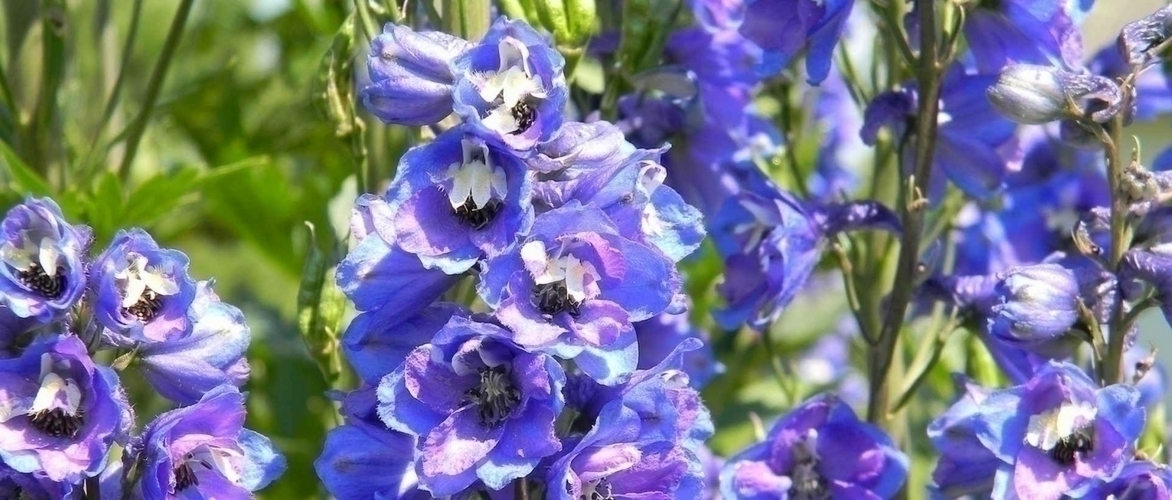
Delphiniums, larkspur : planting, sowing and care
Contents
Delphiniums in a nutshell
- They are among the most structural perennial plants
- Their flowering lasts for over a month
- Their flowers offer quite rare shades of blue
- They need sun to thrive
- Emblematic of English gardens and cottage gardens, they are spectacular!
A word from our expert
Delphiniums, often referred to as larkspurs or dolphin flowers, are emblematic of English gardens. They are highly valued for structuring prairie-style gardens and are precious for introducing vertical accents and focal points at the back of borders, in beds, or in pots near the house.
Majestic yet delicate, their long floral spikes can reach nearly 2 metres and come in ramified or dense spikes of pure blues, purples, whites, yellows, pinks, or reds depending on the variety. They thrive in full sun from June to October, depending on the variety, in rich, deep, well-drained soils.
These beautiful tall perennials are not the easiest to grow and maintain: quite tender, they often take one to three years to truly establish but then produce a lovely clump of dozens of floral spikes by late spring that require only a little care to bloom generously again at the end of summer.
When cut, their majestic inflorescences make very pretty bouquets with a rustic charm.
Delphiniums are perfect plants for playing with contrasts, shades, and gradients, transforming a border into a remarkable impressionist tableau: they combine beautifully in opulent spring and summer scenes with perennials and old roses in particular. They add charm to English cottages and turn a simple perennial bed into a chic mixed border!
Botany
Botanical data
- Latin name Delphiniums
- Family Ranunculaceae
- Common name Larkspur, Althea
- Flowering from June to October
- Height up to 2 metres
- Exposure Sun
- Soil type All
- Hardiness below -15°
The genus Delphinium, the Larkspurs (belonging to the family Ranunculaceae), comprises nearly 400 species. Most are perennials, with a few annuals and biennials. The Delphiniums derive their name from their floral buds extended by a long spur, resembling the shape of a dolphin’s rostrum. These herbaceous and hardy plants are primarily native to temperate regions of the Northern Hemisphere. The delphinium thrives almost everywhere in France, except in very windy areas.
There are hundreds of varieties of Larkspur, most of which are perennials, with a few annuals and biennials. The various cultivars of delphiniums are divided into different groups. The most commonly cultivated are delphinium grandiflorum, the giant delphiniums of the Elatum group (up to 2 m at maturity), the hybrids Pacific, and the robust, loosely ramified ones from the Belladonna group. The cultivars from the Elatum group and their hybrids are the most common in gardens. The main selection criteria are flower colour and height, offering great diversity.
Delphiniums have an upright bushy habit and form a graceful clump with a diameter ranging from 20 to 60 cm depending on the species and the age of the plant. Most Larkspurs have fibrous or fleshy roots, sometimes tuberous. Don’t be too impatient: it takes a few years to see them form beautiful clumps. However, once well developed, they should be divided every 3 to 4 years to ensure the longevity of the plant—plants lose vigour as they age—and to maintain magnificent flowering. While Delphiniums are perfectly hardy, the perennial species can sometimes be ephemeral (notably the Pacific hybrids) with a relatively short lifespan of about ten years: division will therefore help regenerate them and keep them for a long time.
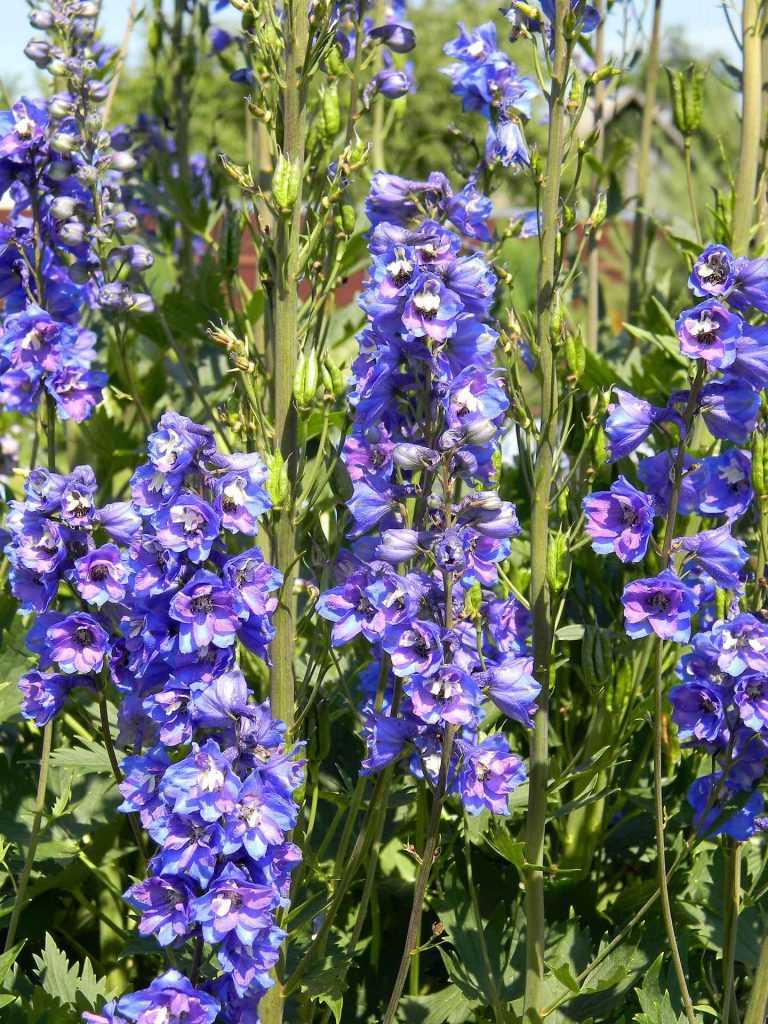
Proudly upright spikes
These very floriferous perennials are always very noticeable in a garden: their majestic flowers bloom for several weeks from June to August depending on the varieties and sometimes again in October if the plants have been cut back after flowering. The flower spike is upright, and its height varies greatly depending on the species, from a few dozen centimetres to over 2 m.
Depending on the species, the very dense or, conversely, more flexible spikes consist of numerous delicate flowers 2 to 9 cm in diameter, cup-shaped, single or double, spurred, sometimes hooded, resembling a gnome’s hat.
The silhouette of the Delphinium flower mainly depends on the size and colour of the five large sepals; the true petals are much smaller and transformed into a sort of small eye at the centre of the flower, called a bee or fly. The numerous species and varieties of delphiniums offer a wide range of colours, from pastels to vibrant shades, but blue is the most common hue. From sky blue to cyan blue, lavender to purple, lilac to mauve, delphiniums are among the most beautiful blue flowers in the garden. White, yellow, pink, or red complete the palette.
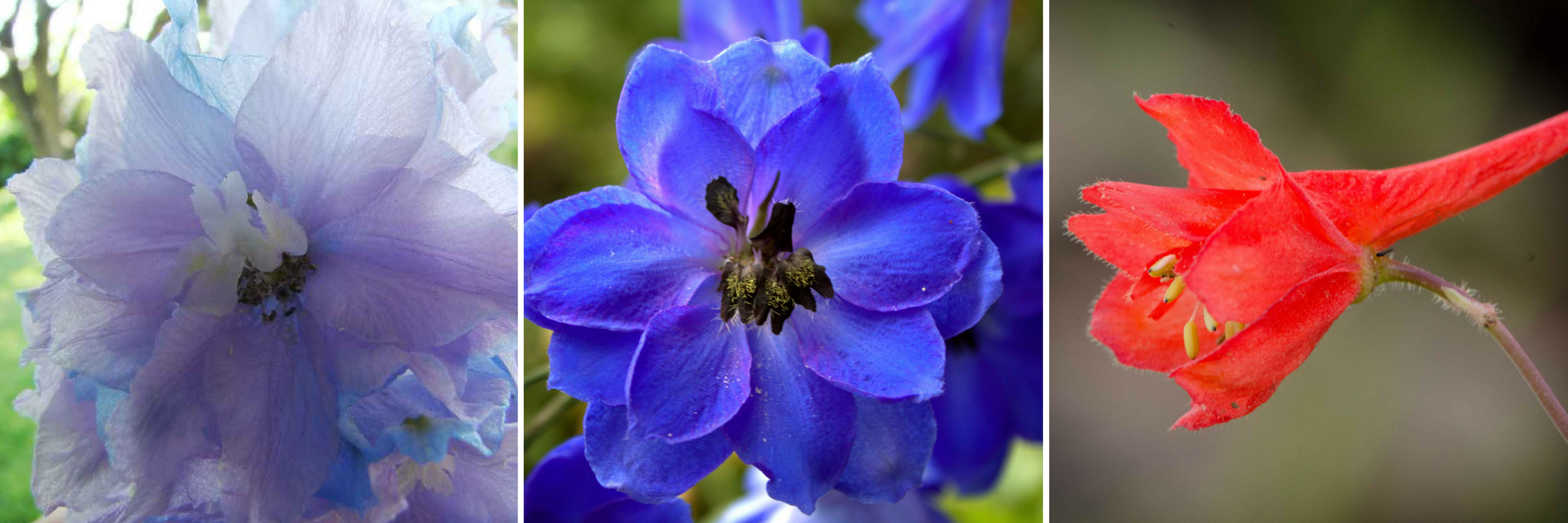
Delphiniums offer a great diversity of colours
Delphiniums have sometimes been criticised for their single flowering in June (maximum 15 days for plants from the Elatum group), but making them bloom again is easy: cut the faded spikes above the leaves, regularly remove the withered flowers: a second flowering in September is guaranteed! Nature being well made: secondary spikes can form below the main spike, extending the flowering by two weeks.
Although the flowers of the delphinium are not fragrant, they are very melliferous and attract many butterflies, foraging insects, and pollinators.
Delphiniums make very lovely bouquets of fresh flowers. Harvested when three-quarters open, the flower spikes will remain beautiful in a vase for about 2 weeks. By drying them upside down, they will continue to brighten your home in a dried flower bouquet with a rustic spirit.
The medium green leaves, 10 to 20 cm long, are dentate and deeply divided into three to seven lobes, sometimes slightly villous. Their size decreases towards the upper part of the stem. Deciduous, they disappear in winter. In spring, gastropods love the young shoots: beware of slugs and snails that can cause havoc at the beginning of the growing season.

Quite demanding, less simple to cultivate than it seems, delphiniums prefer fertile, deep, humus-rich, cool soils, even in summer, and well-drained. They dislike both heavy, wet soils and dry, poor soils. They thrive in well-sunny situations, protected from strong winds and winter moisture. Apart from dwarf species, delphiniums, especially the tall ones, require staking, especially if exposed to wind: their long flower stems break like glass and at the slightest gust of wind, they will snap under the weight of the many flowers.
Delphiniums fit into all settings and can serve as dazzling background plants or flowers for borders or pots, appearing very sophisticated or more discreet. The vertical dimension they provide helps structure both a geometric and orderly border as well as a garden with a rustic or meadow-like appearance. Reliable values in herbaceous borders and soft gardens, they are appreciated for their majestic clusters of flowers, white, pink, but most often blue. The tall, very structuring silhouettes of the “Pacific Giant” group are classics in English gardens. Others integrate wonderfully into natural gardens alongside Oriental poppies, cornflowers, and daisies to create a marriage that is both exuberant and ephemeral. They are essential in sunny gardens and, of course, blue gardens. Delphiniums generally bloom during the rose season, at the end of spring and the beginning of summer, making them excellent partners for old roses.
All parts of the plant are toxic; contact with the leaves may irritate the skin.
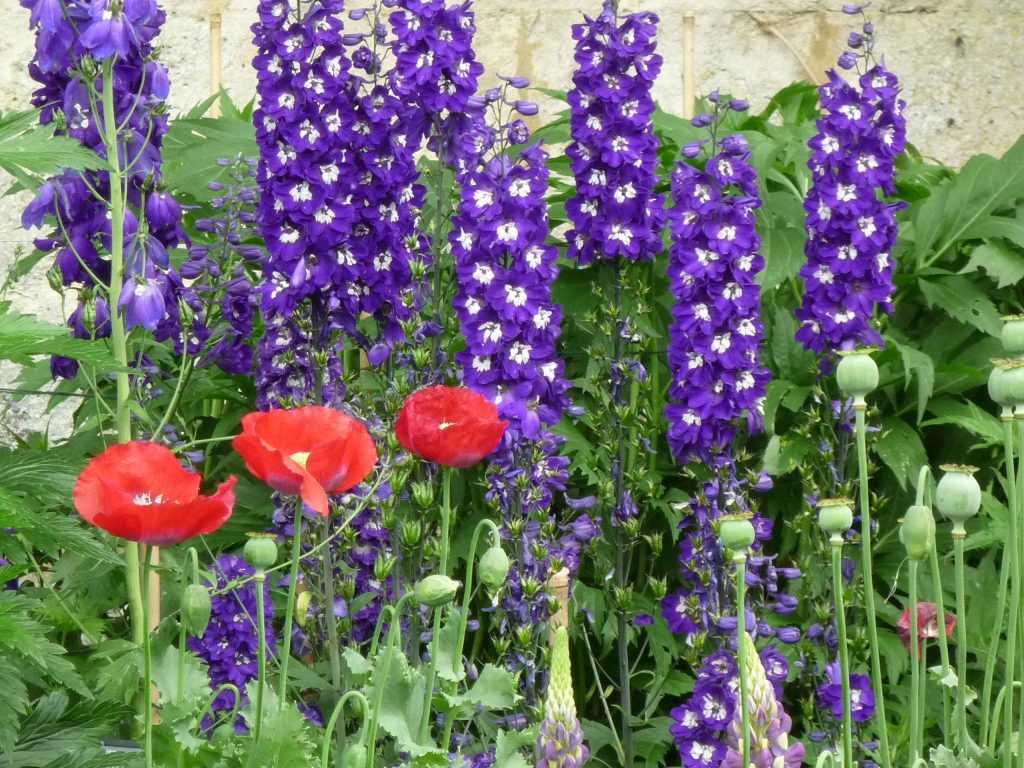
Species and main varieties
The different cultivars of delphiniums are divided into various groups:
The Belladonna Group
With a tousled appearance, these are excellent garden delphiniums featuring simple and delicate flowers in blue, white, or violet, measuring 2 to 4 cm in diameter, making them ideal plants for unconventional borders. These perennials with large, finely divided palmate leaves offer abundant flowering from June to July and then from August to October. Stiff stems measuring 0.80 to 1.40 m in height bear branched, slender, and loose spikes, perfect for rustic bouquets as well. Delphiniums from this group, being shorter, are less susceptible to wind action, more resilient, and have a longer lifespan than taller varieties.
The Elatum Group
This is the catch-all name for traditional border delphiniums. They are the most common in gardens, but also the tallest, classified by their height: up to 1.50 m, up to 1.70 m, and up to 2 m and more. Their shape differs from the Belladonna: these hybrids have a more compact inflorescence. The rigid and thick stems end with magnificent dense spikes and large flat flowers, either single, double, or semi-double, in blue, violet, white, or old rose, appearing from June to August, sometimes again in October. Most perennial delphiniums descend from this group. The numerous cultivars and hybrids of this group are categorized as follows:
- The Pacific Hybrid Series
The famous Pacific Giants series, rich in pure colours or highlighted with white eyes, features either single or semi-double flowers. The Pacifics are remarkable recent hybrids for the size of their inflorescences, measuring 1m to 1.20 m long on numerous stems of 1.80 to 2 m. Developed in California, they share the same characteristics as the Elatum group, but being seed-grown, they are more variable in terms of colours. The large flowers (5 to 7 cm in diameter), semi-double, form beautiful dense spikes from June to August, striking as cut flowers.
- The Magic Fountains Series
This is the dwarf version of the Pacific Hybrid series. Reproducible by sowing, it produces clusters of 30 to 50 cm in pure blue, mauve, pink, white… The Magic Fountains series offers more compact delphiniums.
Delphinium grandiflorum or D. chinense
Often grown as an annual, this bushy dwarf plant reaches 50 cm in height and bears light panicles of pretty simple flowers in the shape of a goblin’s hat in blue, violet, or white from June to July.
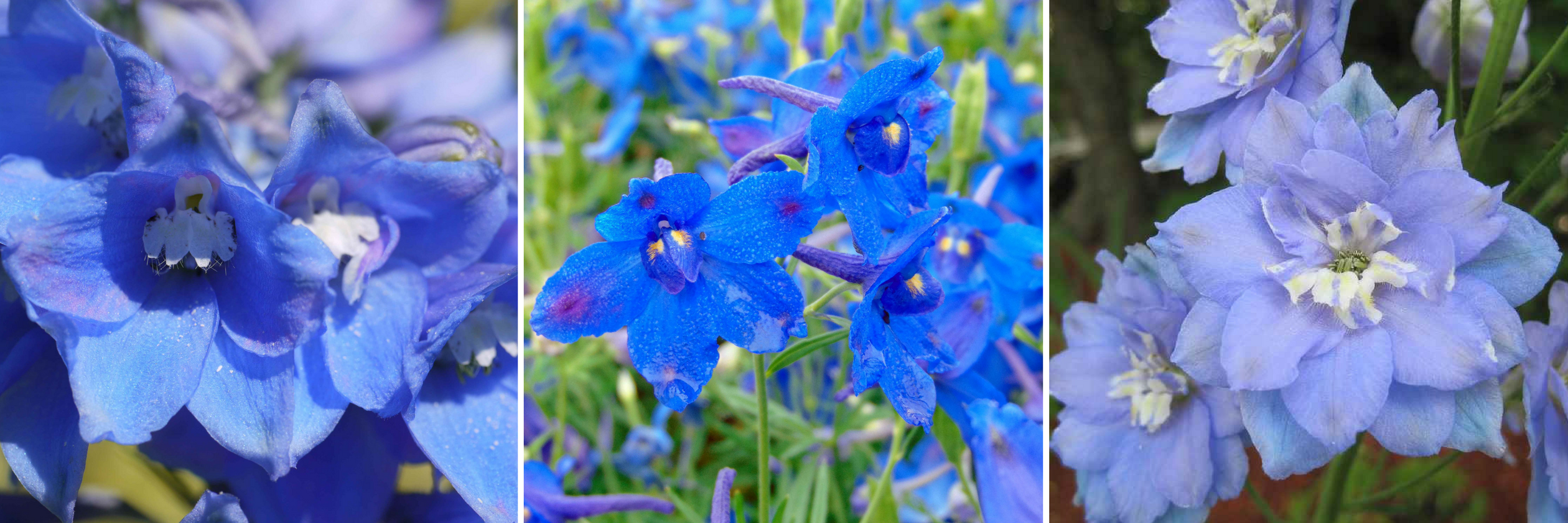 Delphinium Belladonna “Piccolo” – D. Grandiflorum ‘sinensis’ – D. Elatum ‘Morning lights bloom’ –
Delphinium Belladonna “Piccolo” – D. Grandiflorum ‘sinensis’ – D. Elatum ‘Morning lights bloom’ –

Delphinium Guinevere Group - Larkspur
- Flowering time July to October
- Height at maturity 1,80 m
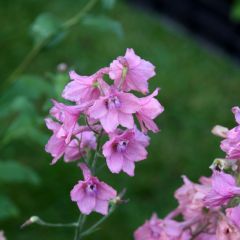
Delphinium Pink Sensation - Larkspur
- Flowering time July to September
- Height at maturity 80 cm
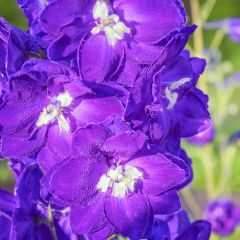
Delphinium King Arthur - Larkspur
- Flowering time July to October
- Height at maturity 1,80 m
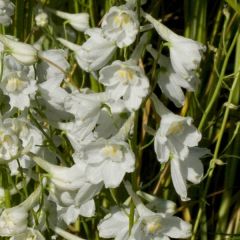
Delphinium Casa Blanca - Larkspur
- Flowering time July to October
- Height at maturity 1,20 m
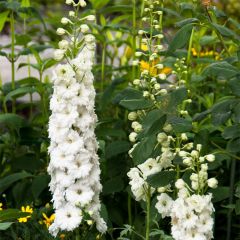
Delphinium elatum Double Innocence - Larkspur
- Flowering time July, August
- Height at maturity 1,50 m
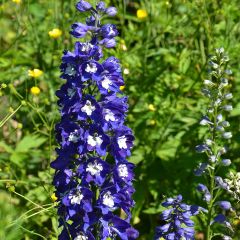
Delphinium Groupe Pacific-hybrid Blue Bird - Larkspur
- Flowering time July to October
- Height at maturity 1,80 m
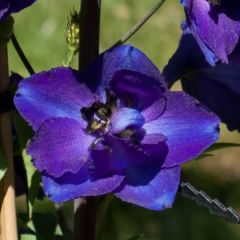
Delphinium belladonna Bellamosum - Larkspur
- Flowering time July to November
- Height at maturity 1,20 m
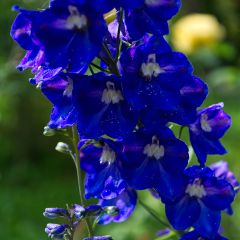
Delphinium Völkerfrieden - Larkspur
- Flowering time July to October
- Height at maturity 2 m
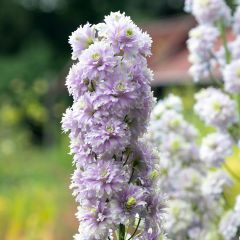
Delphinium Crystal Delight - Larkspur
- Flowering time August to October
- Height at maturity 1,20 m
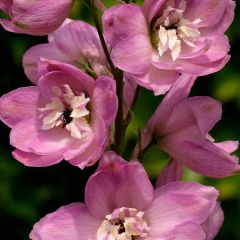
Delphinium Astolat Group - Larkspur
- Flowering time July to October
- Height at maturity 1,50 m
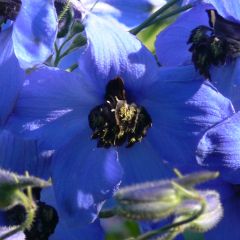
Delphinium Finsteraarhorn - Larkspur
- Flowering time July to October
- Height at maturity 1,80 m
Discover other Delphinium - Larkspur
View all →Available in 0 sizes
Available in 0 sizes
Available in 0 sizes
Available in 2 sizes
Available in 1 sizes
Available in 2 sizes
Available in 3 sizes
Available in 1 sizes
Available in 1 sizes
Available in 1 sizes
Planting
Where to plant the delphinium?
The delphinium thrives in most parts of France, except in very windy regions, and in dry, poor, or heavy soil.
The delphinium is not the easiest plant to grow; despite its appearance as a large, easy perennial, it is quite demanding. It prefers to be placed in a sunny spot, sheltered from strong winds and well-exposed, which encourages the plant to reach its full height.
It fits into all settings, borders or beds, but it truly shines as a background plant in borders. The tallest varieties should be planted at the back of borders, providing depth and striking verticality.
It enjoys fertile, deep, cool soils, even in summer, and very well-drained conditions. In poor soil, it will never be lush. In heavy, wet soil, it will languish and die or grow very slowly. If you wish to try growing it despite this, adding sand and gravel at planting will help the delphinium establish itself.
The needs vary greatly from one species to another: Elatum hybrids are more tolerant of soil type, but all have retained, from their montane origins, an impressive hardiness. The harsher the winter, the more beautiful the delphinium becomes; it can withstand temperatures below -15°C but does not like winter moisture. Ensure it is planted in a dry spot, in a location without excess water in winter. In summer, however, water generously during dry spells.
A situation that is too windy will pose a threat to these tall perennials. Except for dwarf species, delphiniums require staking to prevent the stems from breaking at the slightest gust of wind: a strong gust and your border will look like a battlefield after the storm! Install supports before April, or when the plants reach 30 cm in height.
Therefore, it is unnecessary to attempt to grow it in dry or heavy soil, in shade, or in very windy regions; you will be disappointed: we recommend planting it where it will look its best: in the sun, sheltered from the wind, and in good, well-drained soil. Understand that if planted in unfavourable conditions, it will require care.
Pot cultivation is not advisable for these plants that prefer coolness and deep soil; however, it is possible with some precautions. More than in open ground, potted delphiniums require fertilisers and sunlight. Dwarf varieties of Elatum or the impressive Delphinium grandiflorum will thrive in a well-sunny position (at least 5 hours of sunlight per day), in a container at least 30 cm deep with potting soil enriched with good compost or well-decomposed manure, water, and don’t forget the stakes.
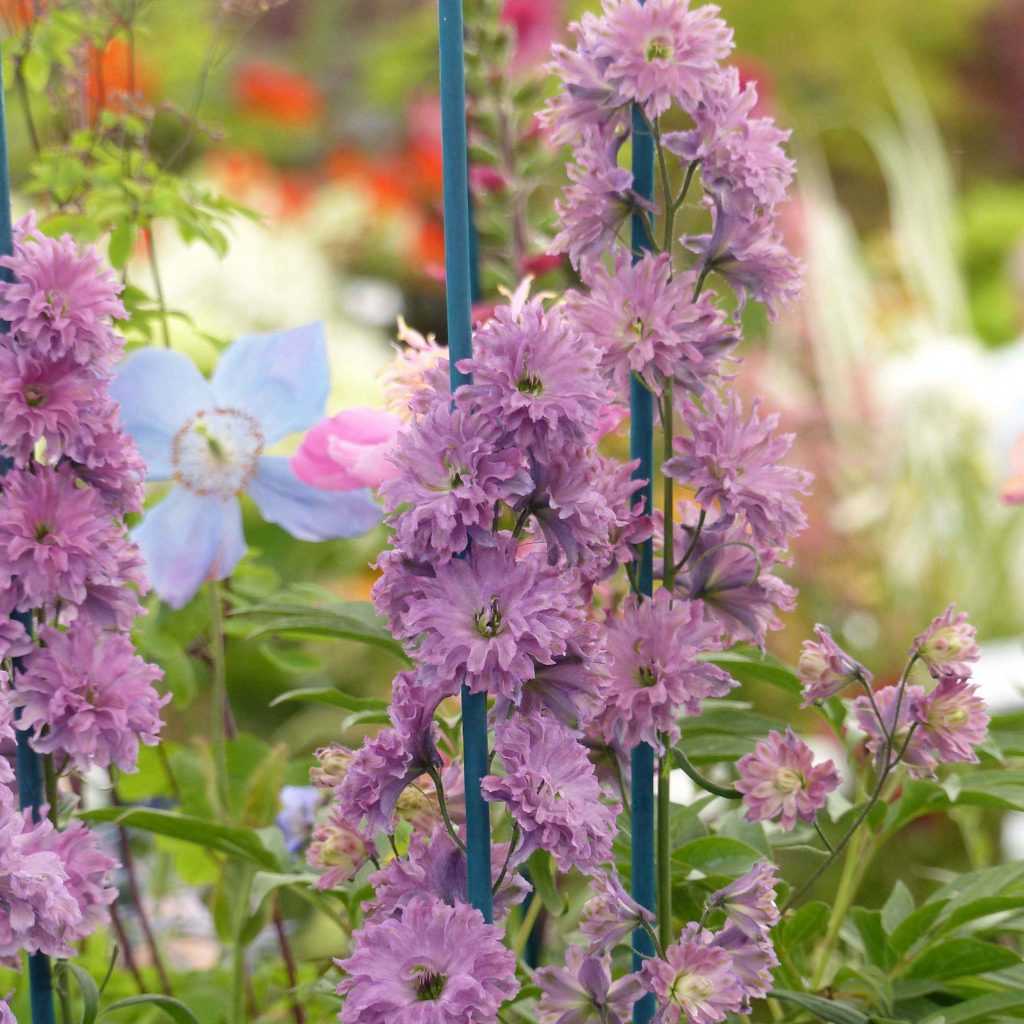
When to plant?
Ideally in autumn or spring in March-April after the last frosts in fertile, well-drained soil.
How to plant?
- Plant in a sunny position, in deep, cool soil, without excess lime, rich and well-drained.
- If your soil is heavy and compact, add potting soil and blonde peat at planting. Ideally, it is better to incorporate well-decomposed manure long before planting or a natural organic fertiliser.
- Plant in buckets in groups of 3 to 5 plants per m², spaced 0.40 to 0.75 cm apart depending on the varieties. For a beautiful effect in a border, it is preferable to plant in numbers.
- Leave at least two or three shoots on young plants and five to seven on already well-established delphiniums.
- As the foliage disappears in winter, it is wise to mark the location of the plants with a small stake, to monitor for snails and slugs in spring.
- During growth, water once or twice a week and apply a liquid fertiliser every two to three weeks. In subsequent years, apply fertiliser in spring to maintain soil fertility, along with humus and compost to retain moisture.
To learn everything about planting delphiniums, discover our planting guide: “Planting and succeeding with delphiniums”
Read also
Plant and succeed with delphiniumsCare and pruning
- Staking the stems of tall varieties securely in spring, at the start of growth.
- To ensure vigorous growth, cut back all weak shoots to the collar from April onwards.
- Remove the inflorescences promptly after flowering to encourage a second autumn flowering. As for annual varieties, allow them to seed for spontaneous sowing. If you wish to collect seeds, leave one flower spike per plant (over 2 years old).
- After flowering, cut back the faded flower stems by half (this will prevent the plant from becoming exhausted) and allow ipomoeas to climb up them, for example.
- Preferably cut them back to ground level in spring, at the start of vegetation, to prevent water and moisture from entering the hollow stems during winter, causing the clumps to rot.
- The soil should be kept moist. Apply mulch and water regularly.
Young plants lose vigour as they age and can disappear quickly (often within three years): beyond 5 years, flowering becomes weak. Therefore, do not hesitate to change or divide the plants if you want to maintain their vigour.
Diseases and potential pests
Delphiniums have well-known enemies:
- snails and slugs that devour young shoots before they even emerge from the soil in spring. A slug treatment, applied at planting and then every year from February, is essential.
- downy mildew and powdery mildew. Spray Bordeaux mixture, sulphur, as well as nettle and horsetail manure as a preventive measure. Do not leave any residues of diseased plants on the ground; burn them.
Propagating
Sowing
- Seeds are harvested and sown as soon as they reach ripeness in summer, provided you haven’t cut all the flower spikes; otherwise, buy them in packets. Annual species generally self-sow spontaneously and do not transplant well, which is why they are sown in place in spring. The secret to germinating delphiniums is freshness. Delphinium seeds have high seed viability during the first year after harvest.
- Store them in the refrigerator and sow them in a warm environment, preferably in spring, on moist compost, barely covering them with potting soil kept moist at a constant temperature between 18 and 22°C. Germination takes one to four weeks.
- Transplant seedlings as soon as the first leaves appear. Sowing done in February-March will yield flowers from August to October the following year. They will bloom earlier in subsequent years and produce taller and more floriferous flower spikes.
Spring sowings bloom between July and September and do not exceed 60 to 90 cm in height in the first year. The following year, flowering is shifted to May-June, and the plant reaches 1.30 m. Sowing rarely produces plants true to the parent plant.
Successfully sowing delphiniums remains a simple operation, but the colour obtained will be random; conversely, division and propagation by cuttings guarantee robust plants true to colour.
→ Learn more in our tutorial on sowing Delphinium!
Division
Dividing the stumps concerns perennial species. Delphinium has a relatively short lifespan of about 4 years, at which point it begins to form a beautiful clump. However, once well established, it should be divided every 3 to 4 years to ensure the longevity of the plant and maintain beautiful blooms. “Divide to preserve”: that’s the approach to take with these fugacious perennials!
At the end of winter or in summer, during the summer dormancy, dig up the plant with pruning shears or a spade, divide it into several sections containing both roots and shoots. Immediately replant the outer sections.
Propagation by Cuttings
The best delphiniums for borders are propagated by cuttings. Operate in March or April, when the vegetation starts, as taking cuttings is easier at this time. Like division, it allows for the exact reproduction of the parent plant. This is done with shoots taken from plants aged 3 or 4 years. When the clump reaches 15 to 20 cm in height, take young shoots of 7 to 10 cm from their base, at the collar level. Plant in a light, well-draining mix (sand, vermiculite, turf…) at 15 to 20°C. Root formation takes four to five weeks. When new leaves appear, the cuttings will be ready to transplant into the open ground.
Allow the shoots to develop; you will obtain beautiful flowers from August to October. And be sure to stake the young plants to prevent the stems from breaking.
→ Learn more with Virginie’s tutorial: How to propagate Delphinium by cuttings?
Associating
Delphiniums are very easy to pair. Reliable choices for herbaceous borders and cottage gardens, they are appreciated for their majestic clusters of flowers, white, pink, but most often blue. The tall, structured silhouettes of the “Pacific Giant” group are classics in English gardens. The delphiniums belonging to the Belladona group, less compact, shorter (1.20 m), more ramified and graceful, integrate beautifully into natural gardens alongside Oriental poppies, cornflowers, and daisies, creating a combination that is as exuberant as it is ephemeral. They are essential for sunny gardens and, of course, blue gardens.
Blue/gold, purple/lavender, or cream yellow/sweet orange, delphiniums are perfect plants for playing with contrasts, shades, and gradients, transforming a border into a remarkable impressionist tableau.
Delphiniums generally bloom during the rose season, at the end of spring and the beginning of summer, making them excellent partners for old roses, with which they create charming and romantic scenes. You can also create another beautiful combination with sweet orange daylilies, gypsophila ‘Rosenschleier’, or sea kale.
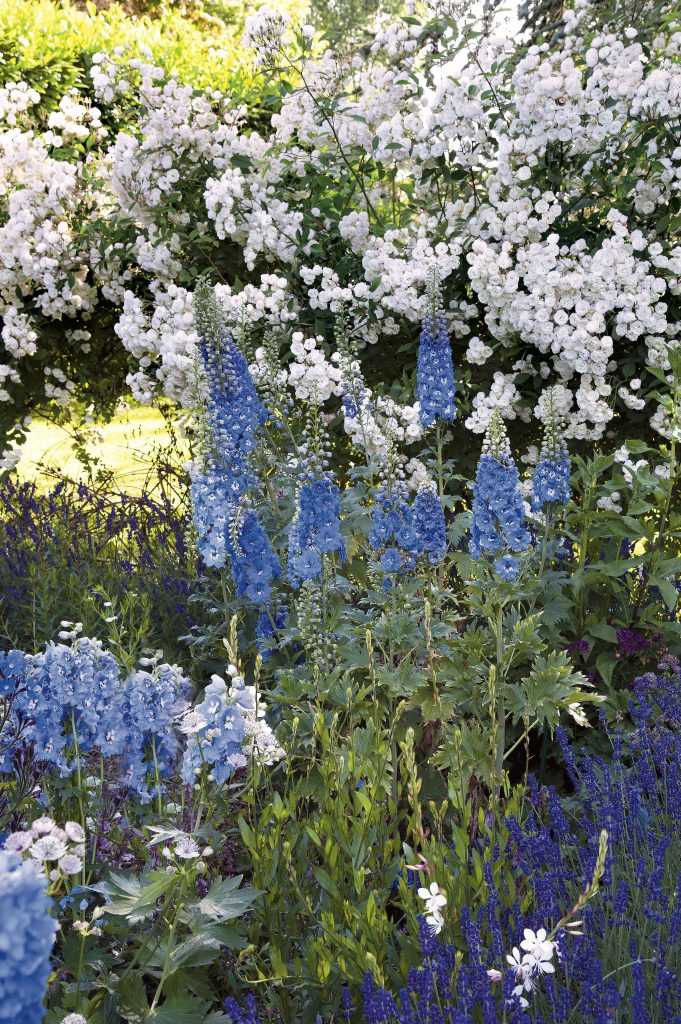
Roses ‘Blushing Bride’ – Lavandula angustifolia – Delphinium New Millenium ‘Royal Aspirations’ and ‘Sunny Skies’ – Astrantia major
Discover even more pairing ideas in our advice sheet: “Delphinium, larkspur – 8 ideas for pairing”
Useful resources
- We offer you one of the most beautiful delphinium collections
- Our advice sheet: Planting and succeeding with delphiniums
- Discover our tips for growing delphinium in pots for a magnificent flowering
Frequently asked questions
-
My delphinium isn't growing and is stagnating. What should I do?
Patience is key. Plants do not all grow at the same rate, and it is quite possible that your delphinium needs a little more time to establish its roots. Young plants set out in spring tend to remain relatively weak in their first year: a good addition of fertiliser or well-rotted compost helps them get started. Be patient, and you will be rewarded the following year with a burst of flowers.
-
Planted in spring, my delphinium has almost disappeared, why?
It is very likely that it has suffered an attack from slugs or snails. Gastropods love young delphinium shoots and barely give them time to emerge from the soil. Be vigilant: mark your young plants with a small stake, so you can monitor slugs and snails in spring. A slug deterrent, spread at planting time and then every year from March before growth begins, helps to anticipate attacks and is sufficient to limit damage.
-
My delphiniums break very easily, what should I do?
They need to be staked just before flowering: a heavy downpour, a gust of wind, and their stems break like glass under the weight of the flowers.
-
I missed my delphinium sowing, why?
It is possible that your seeds have been poorly stored or kept for too long: delphinium seeds have high seed viability during the first year following their harvest. They should be stored in the refrigerator and then sown in a warm environment, preferably in spring, on moist compost, barely covering them with soil kept moist at a constant temperature between 18 and 22°C. Germination takes one to four weeks. Once the young plants are well developed (3 mature leaves) after about four weeks, they should be transplanted to their final location, in full sun, with very deep, well-manured soil that remains cool, and all that’s left is to stake them.
- Subscribe!
- Contents































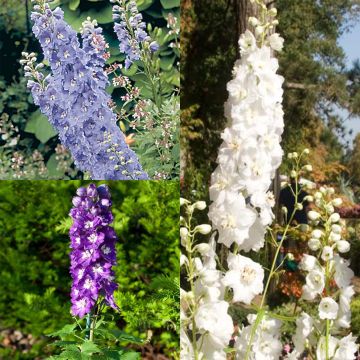
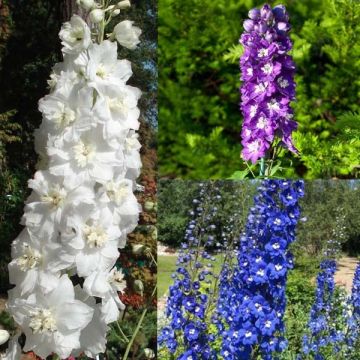
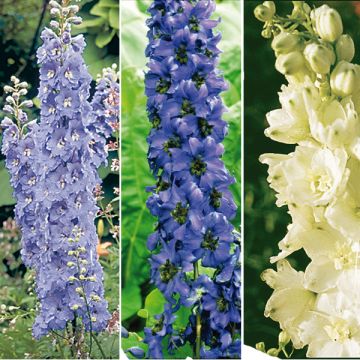
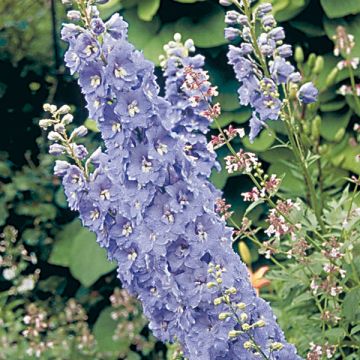
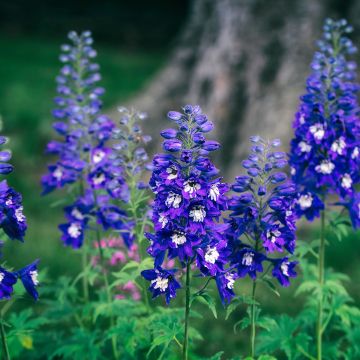
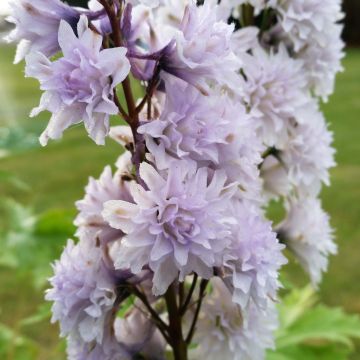

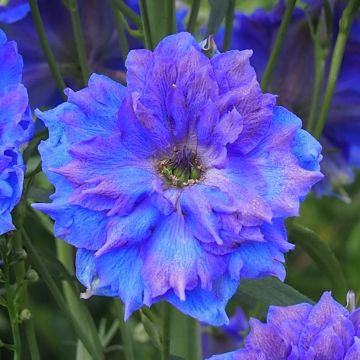
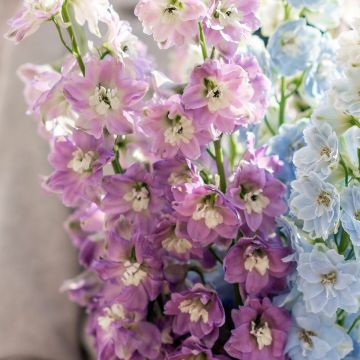

Comments